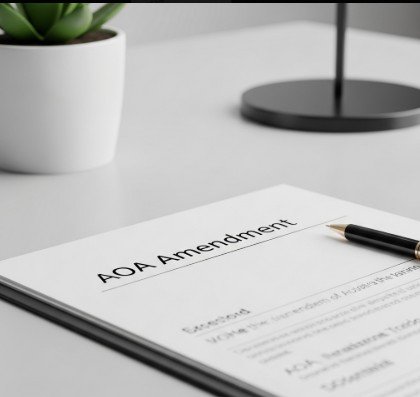
The Articles of Association (AOA) serve as the rulebook for a company’s internal governance. From shareholder rights to board meetings, these articles dictate how a company operates. However, as businesses evolve, so must their governing documents. That’s where Amendment of Articles of Association come in—ensuring your company stays aligned with its objectives, legal requirements, and strategic direction.
Table of Contents
What is an Amendment of Articles of Association (AOA)?
The AOA is a legally binding document that outlines a company’s internal management, operational framework, and decision-making processes. It works alongside the Memorandum of Association (MOA) to define how a company functions.
Key Elements of an AOA:
- Board of Directors – Roles, responsibilities, and appointment/removal procedures.
- Shareholder Rights – Voting rights, dividend distribution, and share transfer rules.
- Meetings & Resolutions – Guidelines for board meetings and general meetings.
- Share Capital – Issuance, transfer, and classification of shares.
- Profit Distribution – How profits are allocated among shareholders.
- Borrowing Powers – Rules on company loans and financial obligations.
- Company Closure – Steps for winding up the business.
Since companies evolve, the AOA must be updated to reflect any major operational or legal changes.
Why Amend the Articles of Association?
Amending the AOA is necessary when a company undergoes structural, regulatory, or strategic changes. Some common reasons include:
1. Conversion of Company Type
- Private to Public Company – Adjusting the AOA to meet public company compliance requirements.
- Public to Private Company – Restricting shareholder rights and modifying governance structures.
2. Change in Business Operations
- Expanding into new industries or altering business activities.
3. Changes in Share Capital Structure
- Increase or reduction in share capital.
- Introduction of new share classes or changes in existing share rights.
4. Change in Company Name
- Updating the AOA to reflect a rebranded business identity.
5. Change in Registered Office
- Moving the registered office to a different state or jurisdiction.
6. Changes in Governance and Board Structure
- Modifying the powers, roles, or composition of the Board of Directors.
7. Compliance with New Legal Requirements
- Updating the AOA to comply with revised corporate laws or regulatory mandates.
Regardless of the reason, AOA amendments must follow the legal procedures outlined in the Companies Act.
How to Amend the Articles of Association (AOA)?
The AOA amendment process involves several key steps to ensure compliance with the Companies Act, 2013.
Step 1: Board of Directors Approval
- Call a Board Meeting to propose the AOA amendment.
- Pass a Board Resolution approving the changes.
- Schedule a General Meeting for shareholder approval.
Step 2: Shareholder Approval at General Meeting
- Issue a 21-day notice for an Extraordinary General Meeting (EGM).
- Pass a Special Resolution with at least 75% shareholder approval.
Step 3: File Form MGT-14 with ROC
- Submit Form MGT-14 within 30 days of passing the Special Resolution.
- Attach the following documents:
- Certified copy of the Special Resolution.
- Notice of the General Meeting.
- Altered AOA with updated provisions.
Step 4: Effectiveness of AOA Amendment
- Once approved by the Registrar of Companies (ROC), the amended AOA becomes legally enforceable.
- Companies must update all official records and inform relevant stakeholders.
Legal Considerations for AOA Amendments
When altering the AOA, companies must:
✔ Ensure compliance with the Companies Act, 2013.
✔ Obtain shareholder approval via a Special Resolution.
✔ Follow prescribed timelines for filing with the ROC.
✔ Update all copies of the AOA to reflect the amendments.
💡 Note: Unlike some legal filings, no stamp duty is required for AOA amendments.
Simplify Your AOA Amendment with Compliance Monk!
Amending an AOA involves multiple legal steps, strict timelines, and compliance requirements. At Compliance Monk, we take care of everything—from drafting resolutions to filing with the ROC—so you can focus on your business.
📞 Contact our experts today and make your AOA amendments stress-free!
FAQs on Articles of Association (AOA) Amendment
1. What is an Articles of Association (AOA) amendment?
An AOA amendment refers to modifying, adding, or removing provisions in a company’s Articles of Association to align with business needs, regulatory requirements, or structural changes.
2. When should a company amend its AOA?
A company may amend its AOA when:
- Converting from a private to a public company (or vice versa).
- Changing business activities or operations.
- Altering share capital structure.
- Modifying shareholder rights or board composition.
- Complying with updated legal or regulatory requirements.
3. What approvals are required for an AOA amendment?
The amendment must be approved through:
- A Board Resolution.
- A Special Resolution passed in a General Meeting with at least 75% shareholder approval.
- Filing with the Registrar of Companies (ROC) through Form MGT-14.
4. How long does it take to amend the AOA?
The process typically takes 30 to 45 days, depending on the time required for board and shareholder approvals, documentation, and ROC processing.
5. What is Form MGT-14, and why is it required?
Form MGT-14 is a mandatory filing submitted to the ROC within 30 days of passing the Special Resolution to register the AOA amendment officially.
6. Is stamp duty applicable on AOA amendments?
No, stamp duty is not required for amending the AOA. It is applicable only at the time of company incorporation.
7. Can an AOA amendment be rejected?
Yes, the ROC may reject an amendment if it does not comply with the Companies Act, lacks proper documentation, or violates shareholder or legal rights.
8. How does an AOA amendment affect company operations?
Once approved, the amended AOA becomes legally binding and dictates the company’s internal governance, ensuring it operates per updated regulations and objectives.
9. Can a company amend its AOA multiple times?
Yes, a company can amend its AOA as needed, provided each amendment follows the required legal process.
